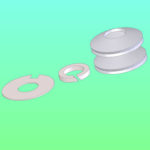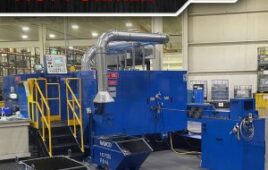~ Article courtesy of Nord-Lock Group
When using hydraulic bolt tensioners to induce a controlled preload into a bolted joint, several key factors including the load transfer factor need to be examined. This is key in ensuring the selected tooling can provide a load greater than the required preload of the joint to overcome any potential losses.

When using hydraulic bolt tensioners, it’s important to ensure the selected tool is capable of providing a load greater than the required preload of the joint.
The load can be lost in a joint due to several factors, including:
• Localized yielding
• Joint deformation
• An imbalance in geometry
It can, however, be observed that the difference in stiffness between the joint structure and the bolt can have an effect on the overall load loss in the joint. Load loss in a joint can be theoretically calculated using varying formulas, primarily based on the known data of the bolt diameter and clamp length.
The resultant value of these calculations is commonly known as the load transfer factor (LTF). The LFT gives a theoretical ratio that can be multiplied against the required preload to generate an applied load, which overcomes the theoretical losses.
Applied load = Preload x LTF
The LTF is important in tool design and tool selection. The maximum output force of the tooling must, at a minimum, match the applied load — but it often exceeds this value.

Load transfer factor or LFT calculations can showcase the need for changes in the loading conditions, joint design, or tensioner design solution.
Careful consideration of the stresses in the joint and bolt is required to ensure loading conditions do not exceed accepted design criteria. In addition, performing the LTF calculation can highlight the need for changes in the loading conditions, joint design, and tensioner design solution.
It’s important to remember that the load transfer factor is a theoretical value and cannot be used to determine the precise load lost within a bolted joint. However, for design and load application, LTF provides loading conditions, which allow for the physical losses within the joint.
For accurate load measurement, systems such as bolt elongation measurement via dial indicators or ultrasonic measurements can be used.
Optimizing bolted joints
To optimize a bolted joint, it’s recommended to design the clamped length to at least three or five times the bolt diameter. Increasing the elasticity of the fastener greatly improves the properties of the joint, as it:
• Increases the elongation of the bolt, reducing the settlement effect
• Increases the flexibility of the fastener, reducing the risk of self-loosening under vibrations and transverse loads
• Improves the load factor, reducing the amplitude of dynamic stresses in the bolt and minimizing the risk of fatigue failure
• Minimizes the load transfer loss in case of hydraulic tensioning
Preventing bolt thread galling and seizing
Galling is caused by a combination of friction and adhesion between metallic surfaces during sliding.

In bolting, thread galling commonly occurs with fasteners made of stainless steel, aluminum, titanium, and other alloys.
When galling occurs, material is adhesively pulled from one surface, leaving it stuck on the other in the form of a lump. This process spreads rapidly as the built-up lumps induce more galling.
The tendency of a material to gall is affected by the material’s ductility. Typically, softer materials are more prone to galling and harder materials are more resistant.
In bolting, thread galling appears during fastener tightening as pressure builds up between the contacting and sliding thread surfaces. Thread galling commonly occurs with fasteners made of stainless steel, aluminum, titanium, and other alloys.
In extreme cases galling leads to seizing — the actual freezing together of the threads and bolt lock-up. Continued tightening may lead to the breakage of the fastener or result in torn-off threads.
The solution:1. Lubricating the internal and/or external threads.
2. Reducing the installation RPM speed.
3. Selecting different stainless alloy grades for the bolt and the nut to reduce galling resulting from different degrees of hardness. Just remember, the strength of the nut always needs to be greater than the strength of the bolt.










Tell Us What You Think!